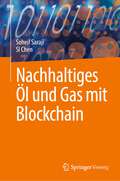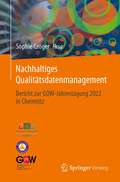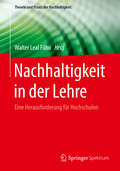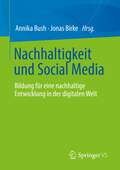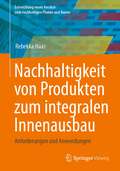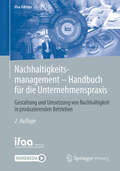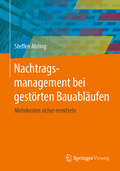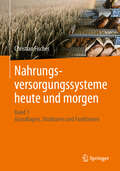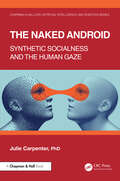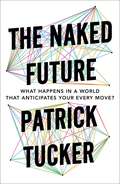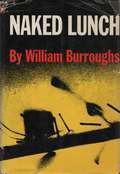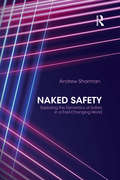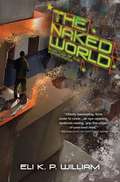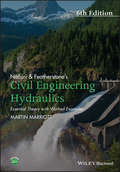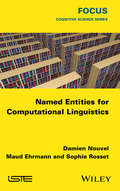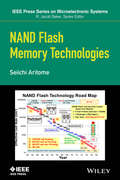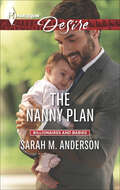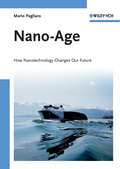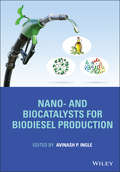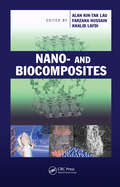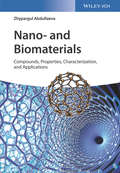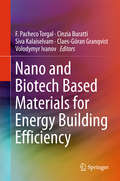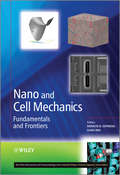- Table View
- List View
Nachhaltiges Öl und Gas mit Blockchain
by Soheil Saraji Si ChenIn dieser Monografie wird das Potenzial der Blockchain-Technologie zur Erleichterung des Übergangs in der Öl- und Gasindustrie untersucht.Während sich die Welt auf eine nachhaltige Energiezukunft zubewegt, steht die Öl- und Gasindustrie vor großen Herausforderungen und Chancen. Das Buch konzentriert sich auf die Entwicklung einer nachhaltigen O&G-Industrie und befasst sich mit der Rolle des Klimas und der Finanzmärkte im Energiesektor, den Anwendungen von Blockchain in der nachhaltigen Energieentwicklung und den Herausforderungen rechtlicher und regulatorischer Fragen bei der Anwendung der Blockchain-Technologie. Es gibt einen Einblick, wie die Energiebranche bereits an der Reduzierung von Kohlenstoffemissionen arbeitet und den Weg in eine nachhaltige Zukunft ebnet, mit detaillierten Beispielen für die Reduzierung von Methanemissionen, Kohlenstoffkreditmärkten, nachhaltigen Flugzeugtreibstoffen und Kunststoffen.Das Buch untersucht auch, wie O&G-Unternehmen ihre Nachhaltigkeitsinitiativen mit Hilfe der Blockchain-Technologie für die Überwachung von Emissionsdaten, die Kohlenstoffabscheidung, -nutzung und -speicherung sowie das Lieferkettenmanagement zur Entwicklung sauberer Produkte vorantreiben können.
Nachhaltiges Qualitätsdatenmanagement: Bericht zur GQW-Jahrestagung 2022 in Chemnitz
by Sophie GrögerDie Gesellschaft für Qualitätswissenschaften e. V. verfolgt seit Ihrer Gründung im Jahre 1994 das Ziel, Qualitätswissenschaft in Lehre und Forschung zu fördern und den Wissenstransfer in die industrielle Anwendung zu unterstützen. Hierzu werden im Rahmen der Jahrestagungen die aktuellen Ergebnisse aus Forschung und Entwicklung vorgestellt und zukünftige Trends in diesem Bereich thematisiert und diskutiert. Die GQW Jahrestagung 2022 fand unter Leitung von Prof. Dr.-Ing. habil. Sophie Gröger in Chemnitz statt. Unter dem Leitthema „Nachhaltiges Qualitätsdatenmanagement“ wurden zahlreiche Beiträge aus Forschung und Industrie vorgestellt. Diese thematisierten dabei beispielsweise die Integration des ISO GPS-Systems in kleine und mittelständische Unternehmen (KMU), eine Vorgehensweise zur fertigungsprozessorientierten Prüfplanung, aber auch die Verknüpfung von Messdaten und Datenbanken zur Vergleichbarkeit von Messergebnissen. Ebenso wurden die Anwendung von Methoden des maschinellen Lernens und die intelligente Qualitätssicherung durch Bildverarbeitung vorgestellt. Es konnte aufgezeigt werden, wie mit der Verknüpfung von Daten im Bereich der Problemlösung eine Verbesserung aktueller Ansätze (8D-Report) erreicht werden kann. Ein Reifegradmodell zur Bewertung der Datenqualität in Industrie 4.0 und eine Informationsbedarfsanalyse für Verbesserungen im Fehlermanagement in der manuellen Montage ergänzten das Tagungsprogramm. Nicht zuletzt wurden neue digitale Möglichkeiten zum Kompetenznachweis sowohl in der Agrar- und Ernährungswirtschaft als auch im Automotive Bereich diskutiert. Freuen Sie sich also auf ein inhaltlich breites Spektrum interessanter Beiträge aus Forschung und Industrie im Bereich der Qualitätswissenschaften.
Nachhaltigkeit in der Lehre: Eine Herausforderung für Hochschulen (Umweltbildung, Umweltkommunikation Und Nachhaltigkeit / Environmental Education, Communication And Sustainability Ser. #19)
by Walter Leal FilhoDieses Buch richtet sich an alle, die das Thema Nachhaltigkeit in der Lehre behandeln möchten. Es trägt zum Erfahrungs- und Informationsaustausch zwischen Lehrenden und Wissenschaftlern bei, und stellt erfolgreiche Ansätze vor, wie das Thema Nachhaltigkeit in der Lehre vermittelt werden kann. An zahlreichen Hochschulen gibt es bereits interessante und attraktive Lehrangebote zu Nachhaltigkeit. Dabei sollte es nicht nur um die Vermittlung von Sachwissen gehen. Nachhaltigkeit in der Lehre beinhaltet, dass sowohl Wissen als auch pragmatische Handlungskompetenzen bei den Studierenden durch inter-, trans- und multidisziplinäre Ansätze gefördert werden. Gerade jetzt, da die Staaten weltweit anstreben, die UN Nachhaltigkeitsziele umzusetzen, ist es dringend erforderlich, dass Nachhaltigkeit in der Lehre durch eine Kombination von Theorie und Praxis eingeführt wird. Hier setzt diese Buch an und zeigt neue Wege auf, wie das Thema Nachhaltigkeit ganzheitlich in der Lehre vermittelt werden kann.
Nachhaltigkeit und Social Media: Bildung für eine nachhaltige Entwicklung in der digitalen Welt
by Annika Bush Jonas BirkeDas Konzept der Nachhaltigkeit erfährt in den letzten Jahren zunehmend Aufmerksamkeit in allen Lebensbereichen. Ob es um Stories zum Klimaschutz auf Instagram, Erklärvideos zur Kreislaufwirtschaft auf YouTube oder Tweets zur Armutsbekämpfung auf Twitter geht - längst hat das Thema auch Einzug in die aufmerksamkeitsstarke Welt von Social Media gefunden. Diese bieten bisher nie dagewesene Möglichkeiten der digitalen Vernetzung und des informellen Lernens. Dadurch rücken sie Nachhaltigkeit verstärkt aus der wissenschaftlichen Nische in den öffentlichen Diskurs.Dieser Sammelband verbindet die bisher zumeist getrennt gedachten Bereiche Nachhaltigkeit und Social Media. Welche nachhaltigen Themen dominieren in den sozialen Netzwerken? Wie werden diese in Facebook rezipiert und auf YouTube diskutiert? Welchen Einfluss hat die Darstellung von ressourcenschonendem Verhalten bei Instagram auf den privaten Alltag? Diesen und weiteren spannenden Fragen wird in diesem Kompendium auf den Grund gegangen. Zwölf innovative Beiträge aus unterschiedlichen Fachdisziplinen untersuchen verschiedene Social Media hinsichtlich der Darstellung und Kommunikation von Nachhaltigkeitsthemen und zeigen, welche Chancen, aber auch welche Herausforderungen sich durch die Verbindung beider Themenkomplexe ergeben. Damit wird ein Beitrag zum wissenschaftlichen und gesellschaftlichen Diskurs beider Bereiche geleistet und die Nachhaltigkeitsforschung im digitalen Raum gestärkt.
Nachhaltigkeit von Produkten zum integralen Innenausbau: Anforderungen und Anwendungen (Entwicklung neuer Ansätze zum nachhaltigen Planen und Bauen)
by Rebekka HaasIntegrale Produkte und Konzepte für den Büroinnenausbau werden auf ihre Nachhaltigkeit betrachtet. Mit Hilfe eines methodischen Vorgehens soll die Frage beantwortet werden, ob die Nachhaltigkeit einer Ausbaufläche durch die integrale Büroflächenkonzipierung beeinflusst wird. Im Zuge dessen wird ein Analysekonzept erarbeitet und anhand einer exemplarischen Fläche angewandt. Es erfolgt die Gegenüberstellung einer konventionellen und einer integralen Ausbauvariante hinsichtlich ausgewählter Nachhaltigkeitsaspekte.
Nachhaltigkeitsmanagement - Handbuch für die Unternehmenspraxis: Gestaltung und Umsetzung von Nachhaltigkeit in produzierenden Betrieben
by ifaa – Institut für angewandte Arbeitswissenschaft e. V.Das Handbuch vermittelt in kompakter Form die Grundlagen und ein praxisorientiertes Konzept zur erfolgreichen Einführung und Verbesserung eines Nachhaltigkeitsmanagements in Unternehmen. Es basiert auf einem ganzheitlichen Verständnis von Nachhaltigkeit, das neben wirtschaftlichen, umweltbezogenen und sozialen Aspekten auch technische Ziele berücksichtigt. Die Inhalte werden strukturiert, übersichtlich und anschaulich dargestellt. Das Handbuch enthält zudem zahlreiche Hinweise sowie praktische Arbeits- und Gestaltungshilfen für betriebliche Akteure.
Nachhaltigkeitsmanagement - Handbuch für die Unternehmenspraxis: Gestaltung und Umsetzung von Nachhaltigkeit in kleinen und mittleren Betrieben (ifaa-Edition)
by ifaa – Institut für angewandte Arbeitswissenschaft e. V.Das Handbuch vermittelt in anschaulicher, praxisorientierter Weise Grundlagen, Inhalte und Vorgehensweise bei der Einführung und Verbesserung eines Nachhaltigkeitsmanagements in Unternehmen. Anhand von Beispielen wird einfach und verständlich dargestellt, wie Unternehmen durch die Gestaltung von Produkten, Unternehmensprozessen und Anlagen ihre Leistungsfähigkeit bei Umweltschutz, Wirtschaftlichkeit und Sozialverantwortung verbessern können. Das Handbuch befähigt die betrieblichen Akteure zur erfolgreichen Umsetzung in ihrem Betrieb. Das Handbuch enthält zudem Anregungen für Unternehmen, die integrierte Managementsysteme bspw. für Umwelt, Qualität und Nachhaltigkeit etablieren oder weiterentwickeln möchten.
Nachtragsmanagement bei gestörten Bauabläufen: Mehrkosten sicher ermitteln
by Steffen AhtingGestörte Bauabläufe sind bei der Durchführung von Bauabläufen längst kein Einzelfall mehr. Um den wirtschaftlichen Erfolg einer Maßnahme dennoch zu sichern und eine verantwortungsgerechte Kostenallokation herzustellen, kann die Seite, welche die Störung nicht zu verantworten hat, berechtigte Mehrkosten zurückfordern oder die Erstattung des entstandenen Schadens von der anderen Partei verlangen. Dieser Leitfaden gibt den am Bau Beteiligten ein entsprechendes Tool an die Hand, die durch Bauablaufstörungen entstehenden Mehrkosten nachvollziehbar und transparent zu berechnen und bietet eine gute Orientierung bei der gesamten Abwicklung von Bauablaufstörungen.
Nahrungsversorgungssysteme heute und morgen: Band 1 - Grundlagen, Strukturen und Funktionen
by Christian FischerWie lassen sich im Jahr 2050 etwa 10 Milliarden Menschen gesund ernähren und nachhaltig mit Nahrungsmittel versorgen? Dieses Buch behandelt in einfachen Worten aber mit der notwendigen inhaltlichen Tiefe einige der dringensten Probleme der Menschheit und diskutiert mögliche Lösungsansätze.Band 1 beschreibt die Grundlagen heutiger Nahrungsvorgungsketten und -systeme („Food Supply Chains and Systems“). Neben Fragen der Ressourcenverfügbarkeit werden alle Stufen der Nahrungsversorgungskette, das heißt die Landwirtschaft und Aquakultur, die Lebensmittelverarbeitung, der Lebensmittelhandel und der Verbrauch in Haushalten und außer Haus behandelt
The Naked Android: Synthetic Socialness and the Human Gaze (Chapman & Hall/CRC Artificial Intelligence and Robotics Series)
by Julie CarpenterThe Naked Android: Synthetic Socialness and the Human Gaze illuminates the connection between the stories people tell, their expectations of what a robot is, and how these beliefs and values manifest in how real robots are designed and used.The introduction of the “human gaze” articulates how peoples’ expectations and perceptions about robots are ultimately based on deeply personal cultural interpretations of what is artificial or human and what problems social robots should –or should not –solve. The Naked Android clarifies how human qualities like understanding and desire are designed into robots as mediums as well as projected onto them by the people who live with them.By investigating the fluidity of identities across human culture and social robotics, this book unpacks the contextual complexities of their interactions and mutual influences. Using ethnographic methods including in-depth interviews with a variety of stakeholders, each chapter explores how people are designing social robots, the experience of living with robots, and people whose jobs it is to dream about a future integrated with robots.Key Features: Introduces the concept of the “human gaze” (and the “robot gaze”) as means of understanding how people live with robots. Each chapter includes in-depth interviews with people who make, live with, or create art about robots. Using ethnographic methods, paints a vivid description of the interconnecting influences of science fiction, human imagination, and real technology.
The Naked Future
by Patrick Tucker"A thorough yet thoroughly digestible book on the ubiquity of data gathering and the unraveling of personal privacy." --Daniel Pink, author of DriveThanks to recent advances in technology, prediction models for individual behavior grow more sophisticated by the day. Whether you'll marry, commit a crime or fall victim to one, or contract a disease are becoming easily accessible facts. The naked future is upon us, and the implications are staggering.Patrick Tucker draws on fascinating stories from health care to urban planning to online dating. He shows how scientists can predict your behavior based on your friends' Twitter updates, anticipate the weather a year from now, figure out the time of day you're most likely to slip back into a bad habit, and guess how well you'll do on a test before you take it.Tucker knows that the rise of Big Data is not always a good thing. But he also shows how we've gained tremendous benefits that we have yet to fully realize.g. Patrick Tucker draws on stories from health care to urban planning to online dating to reveal the shape of a future that's ever more certain. In these pages you'll meet scientists and inventors who can predict your behavior based on your friends' Twitter updates. They are also hacking the New York City sewer system to predict environmental conditions, anticipating how much the weather a year from now will cost an individual farmer, figuring out the time of day you're most likely to slip back into a bad habit, and guessing how well you'll do on a test before you take it. You'll learn how social networks like Facebook are using your data to turn you into an advertisement and why the winning formula for a blockbuster movie is more predictable than ever. The rise of big data and predictive analytics means that governments and corporations are becoming much more effective at accomplishing their goals and at much less cost. Tucker knows that's not always a good thing. But he also shows how we've gained tremendous benefits that we have yet to fully realize. Thanks to the increased power of predictive science, we'll be better able to stay healthy, invest our savings more wisely, learn faster and more efficiently, buy a house in the right neighborhood at the right time, avoid crime, thwart terrorists, and mitigate the consequences of natural disasters. What happens in a future that anticipates your every move? The surprising answer: we'll live better as a result.
The Naked Future
by Patrick TuckerIn the past, the future was opaque--the territory of fortune-tellers, gurus, and dubious local TV weathermen. But thanks to recent advances in computing and the reams of data we create through smartphone and Internet use, prediction models for individual behavior grow smarter and more sophisticated by the day. Whom you should marry, whether you'll commit a crime or fall victim to one, if you'll contract a specific strain of flu--even your precise location at any given moment years into the future--are becoming easily accessible facts. the naked future is upon us, and the implications are staggering. Patrick Tucker draws on stories from health care to urban planning to online dating to reveal the shape of a future that's ever more certain. In these pages you'll meet scientists and inventors who can predict your behavior based on your friends' Twitter updates. They are also hacking the New York City sewer system to predict environmental conditions, anticipating how much the weather a year from now will cost an individual farmer, figuring out the time of day you're most likely to slip back into a bad habit, and guessing how well you'll do on a test before you take it. You'll learn how social networks like Facebook are using your data to turn you into an advertisement and why the winning formula for a blockbuster movie is more predictable than ever. The rise of big data and predictive analytics means that governments and corporations are becoming much more effective at accomplishing their goals and at much less cost. Tucker knows that's not always a good thing. But he also shows how we've gained tremendous benefits that we have yet to fully realize. Thanks to the increased power of predictive science, we'll be better able to stay healthy, invest our savings more wisely, learn faster and more efficiently, buy a house in the right neighborhood at the right time, avoid crime, thwart terrorists, and mitigate the consequences of natural disasters. What happens in a future that anticipates your every move? the surprising answer: we'll live better as a result. 'Where I saw a thrilling and historic transformation in the world's oldest idea--the future--other people saw only Target, Facebook, Google, and the government using their data to surveil, track, and trick them . . . But in fact, your data is your best defense against coercive marketing and intrusive government practices. Your data is nothing less than a superpower waiting to be harnessed. ' from the Introduction
Naked Lunch
by William S. BurroughsDelirious, nonlinear ravings of a junkie in hell. Also includes excerpts from the Boston trial where it was declared not obscene in 1966.
Naked Safety: Exploring The Dynamics of Safety in a Fast-Changing World
by Andrew SharmanWorkplace safety has never been seen as sexy, clever or cool. Fraught with legislative hurdles, ambiguous policy and complex procedures, despite its alleged importance safety has lost its way. For many organisations safety is seen as burdensome and bureaucratic and has become little more than paperwork and performance charts: things done in fear of persecution – from the authorities, the media or the civil arena – rather than doing the right thing. To change the game and build real risk literacy, it’s vital to make things easier, to strip things back to basics and think again about how we work. This is Naked Safety. Encouraging the reader to step outside their comfort zone, this book demystifies workplace safety, challenging traditional views and catalysing critical thought and high-impact action. With narratives on the central pillars of workplace safety including risk management; legal frameworks; performance; governance; leadership and culture, as well as perspectives on key issues that affect safety – and business – more broadly, such as worker wellbeing; employee engagement; the impact of globalisation; corporate social responsibility; sustainability and the role of the safety practitioner, Naked Safety features over 100 actions to bring about positive, sustainable organisational change. This book is a useful, multi-purpose guide for professionals; an indispensable toolkit for practitioners, business leaders, and anyone with an interest in workplace risk and Occupational Safety and Health. Let’s get Naked!
The Naked World: Book Two of the Jubilee Cycle (Jubilee Cycle #2)
by Eli K. WilliamIn a world stripped bare of digital images and promotainment, unveiled with the audiovisual overlay of the ImmaNet, in an exposed world, a naked world, Amon Kenzaki awakens, lost and alone. He must now travel deep into the District of Dreams in search of Rashana Birla, the one person that might help him unravel the mystery of jubilee. But deprived of the apps and informational tools he’s depended on his entire life, traversing the largest bankdeath camp on Earth is no easy task.Inside an ephemeral labyrinth of slowly-dissolving disposable skyscrapers clogged to the limit with the bankdead masses, Amon soon finds himself face to face with two dangerous groups: a cult called the Opportunity Scientists, who preach bizarre superstitions about economic salvation, and a supposedly humanitarian organization called the Philanthropy Syndicate, whose mandate of serving the poor conceals rapacious motives.Amon takes refuge in Xenocryst, a community that genuinely strives to improve conditions in the camps, where he begins to work towards its cause and reconciles himself to his newfound poverty. But when political forces threaten the community’s existence and the lives of its members, he is forced to team up with a vending-machine designer, an Olympic runner, a fertility researcher, a corporate tycoon, and many others to expose the heinous secret festering at the heart of the action-transaction market he once served.In book two of the Jubilee Cycle, Eli K. P. William delves beneath the surface of his cyber-dystopian Tokyo to unearth the fate of outcasts trapped in its depths and shine a light on the financial obstacles blocking one individual’s efforts to help them.Skyhorse Publishing, under our Night Shade and Talos imprints, is proud to publish a broad range of titles for readers interested in science fiction (space opera, time travel, hard SF, alien invasion, near-future dystopia), fantasy (grimdark, sword and sorcery, contemporary urban fantasy, steampunk, alternative history), and horror (zombies, vampires, and the occult and supernatural), and much more. While not every title we publish becomes a New York Times bestseller, a national bestseller, or a Hugo or Nebula award-winner, we are committed to publishing quality books from a diverse group of authors.
Nalluri And Featherstone's Civil Engineering Hydraulics
by Martin MarriottAn update of a classic textbook covering a core subject taught on most civil engineering courses. Civil Engineering Hydraulics, 6th edition contains substantial worked example sections with an online solutions manual. This classic text provides a succinct introduction to the theory of civil engineering hydraulics, together with a large number of worked examples and exercise problems. Each chapter contains theory sections and worked examples, followed by a list of recommended reading and references. There are further problems as a useful resource for students to tackle, and exercises to enable students to assess their understanding. The numerical answers to these are at the back of the book, and solutions are available to download from the book?s companion website.
Named Entities for Computational Linguistics
by Damien Nouvel Sophie Rosset Maud EhrmannOne of the challenges brought on by the digital revolution of the recent decades is the mechanism by which information carried by texts can be extracted in order to access its contents. The processing of named entities remains a very active area of research, which plays a central role in natural language processing technologies and their applications. Named entity recognition, a tool used in information extraction tasks, focuses on recognizing small pieces of information in order to extract information on a larger scale. The authors use written text and examples in French and English to present the necessary elements for the readers to familiarize themselves with the main concepts related to named entities and to discover the problems associated with them, as well as the methods available in practice for solving these issues.
NAND Flash Memory Technologies
by Seiichi AritomeThis book thoroughly describes basic and advanced NAND Flash memory technologies, including the principles of NAND flash, memory cell technologies, multi-bits cell technologies, scaling challenge of memory cell, reliability, and 3-dimensinal cell as the future technology.
The Nanny Plan: The Nanny Plan The Cowgirl's Little Secret From Fake To Forever (Billionaires and Babies #71)
by Sarah M. AndersonThis billionaire bachelor has a baby challenge... Being a father to his orphaned infant niece is out of this tech billionaire's comfort zone. Lucky for Nate Longmire, Trish Hunter is a natural at motherhood, and she's agreed to be his temporary nanny. But long glances, slow kisses and not-so-innocent touches are strictly off-limits... Trish's goal is to help Nate in exchange for a big donation to her charity for Lakota kids. Falling for her bachelor boss-and his adorable baby girl-is not part of the plan. But when the month is up, will she be able to walk away?
Nano-Age: How Nanotechnology Changes Our Future
by Mario PagliaroIs the nano-age here to stay or will a bubble soon burst? This thought-provoking page-turner takes a critical glance at how nanotechnology has affected virtually all areas of our lives. From the pharmaceutical industry to energy production and storage, many fields have been truly revolutionized during the nano-age. The internationally renowned author explores the topic in nine entertaining chapters.
Nano- and Biocatalysts for Biodiesel Production
by Avinash P. IngleReviews recent advances in catalytic biodiesel synthesis, highlighting various nanocatalysts and nano(bio)catalysts developed for effective biodiesel production Nano- and Biocatalysts for Biodiesel Production delivers an essential reference for academic and industrial researchers in biomass valorization and biofuel industries. The book covers both nanocatalysts and biocatalysts, bridging the gap between homogenous and heterogenous catalysis. Readers will learn about the techno-economical and environmental aspects of biodiesel production using different feedstocks and catalysts. They will also discover how nano(bio)catalysts can be used as effective alternatives to conventional catalysts in biodiesel production due to their unique properties, including reusability, high activation energy and rate of reaction, easy recovery, and recyclability. Readers will benefit from the inclusion of: Introductions to CaO nanocatalysts, zeolite nanocatalysts, titanium dioxide-based nanocatalysts and zinc-based in biodiesel production An exploration of carbon-based heterogeneous nanocatalysts for the production of biodiesel Practical discussions of bio-based nano catalysts for biodiesel production and the application of nanoporous materials as heterogeneous catalysts for biodiesel production An analysis of the techno-economical considerations of biodiesel production using different feedstocks Nano- and Biocatalysts for Biodiesel Production focuses on recent advances in the field and offers a complete and informative guide for academic researchers and industrial scientists working in the fields of biofuels and bioenergy, catalysis, biotechnology, bioengineering, nanotechnology, and materials science.
Nano- and Biocomposites
by Alan Kin-Tak Lau Farzana Hussain Khalid LafdiAdvances in nanotechnology are leading to the creation of composites with a myriad of medical applications. This forward-thinking book melds research in biocomposites with advances in nanocomposite technology to provide an interdisciplinary resource on advanced materials for the biomedical industry. It brings together pioneering researchers who describe their contributions to the field. Among other areas, they cover nanostructured polymer composites and nano/bio composites. They look at developments in tissue engineering, safer resins for tooth and bone repair, and improved artificial joints. They also discuss potential opportunities for continued research in this well-funded field.
Nano- and Biomaterials: Compounds, Properties, Characterization, and Applications
by Zhypargul AbdullaevaA comprehensive introduction to nano- and biomaterials shining light on the different research disciplines from various perspectives. The straightforward and well-structured concept is designed to cater for entrants as well as experienced researchers in the field of nanotechnology. The initial chapters introduce nanomaterials, their classification and synthesis techniques, while subsequent chapters discuss the various characterization tools as well as mechanical properties and their applications in biotechnological and biomedical fields. Further understanding of the topic is supported by case studies used for practical purposes. The book concludes with a look at future technology advances. With its explanation of a wide variety of materials, this is an essential reference for chemists, physicists, materials scientists and biomedical engineers.
Nano and Biotech Based Materials for Energy Building Efficiency
by F. Pacheco Torgal Cinzia Buratti Siva Kalaiselvam Claes-Göran Granqvist Volodymyr IvanovThis book presents the current state of knowledge on nanomaterials and their use in buildings, ranging from glazing and vacuum insulation to PCM composites. It also discusses recent applications in organic photovoltaics, photo-bioreactors, bioplastics and foams, making it an exciting read while also providing copious references to current research and applications for those wanting to pursue possible future research directions. Derek Clements-Croome, Emeritus Professor in Architectural Engineering, University of Reading (From the Foreword) Demonstrating how higher energy efficiency in new and existing buildings can help reduce global greenhouse gas emissions, this book details the way in which new technologies, manufacturing processes and products can serve to abate emissions from the energy sector and offer a cost-effective means of improving competitiveness and drive employment. Maximizing reader insights into how nano and biotech materials - such as aerogel based plasters, thermochromic glazings and thermal energy adsorbing glass, amongst others - can provide high energy efficiency performance in buildings, it provides practitioners in the field with an important high-tech tool to tackle key challenges and is essential reading for civil engineers, architects, materials scientists and researchers in the area of the sustainability of the built environment.
Nano and Cell Mechanics: Fundamentals and Frontiers (Microsystem and Nanotechnology Series (ME20) #11)
by Horacio D. Espinosa Gang BaoResearch in nano and cell mechanics has received much attention from the scientific community as a result of society needs and government initiatives to accelerate developments in materials, manufacturing, electronics, medicine and healthcare, energy, and the environment. Engineers and scientists are currently engaging in increasingly complex scientific problems that require interdisciplinary approaches. In this regard, studies in this field draw from fundamentals in atomistic scale phenomena, biology, statistical and continuum mechanics, and multiscale modeling and experimentation. As a result, contributions in these areas are spread over a large number of specialized journals, which prompted the Editors to assemble this book. Nano and Cell Mechanics: Fundamentals and Frontiers brings together many of the new developments in the field for the first time, and covers fundamentals and frontiers in mechanics to accelerate developments in nano- and bio-technologies. Key features: • Provides an overview of recent advances in nano and cell mechanics. • Covers experimental, analytical, and computational tools used to investigate biological and nanoscale phenomena. • Covers fundamentals and frontiers in mechanics to accelerate developments in nano- and bio-technologies. • Presents multiscale-multiphysics modeling and experimentation techniques. • Examines applications in materials, manufacturing, electronics, medicine and healthcare. Nano and Cell Mechanics: Fundamentals and Frontiers is written by internationally recognized experts in theoretical and applied mechanics, applied physics, chemistry, and biology. It is an invaluable reference for graduate students of nano- and bio-technologies, researchers in academia and industry who are working in nano and cell mechanics, and practitioners who are interested in learning about the latest analysis tools. The book can also serve as a text for graduate courses in theoretical and applied mechanics, mechanical engineering, materials science, and applied physics.
